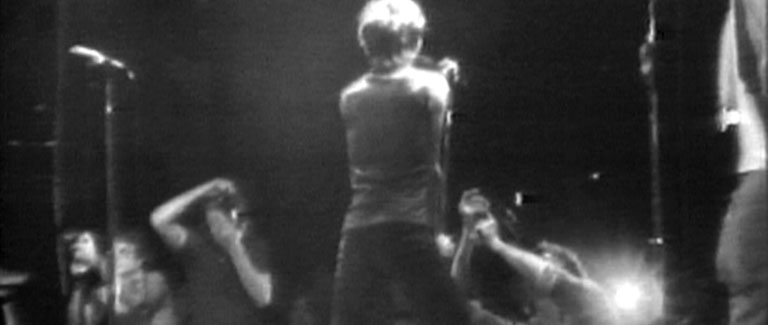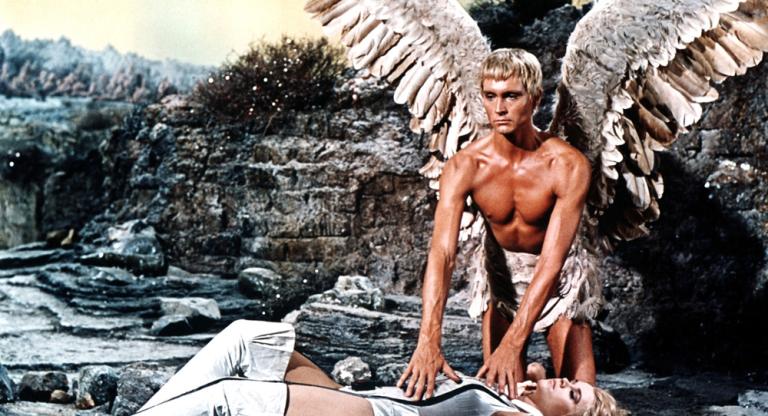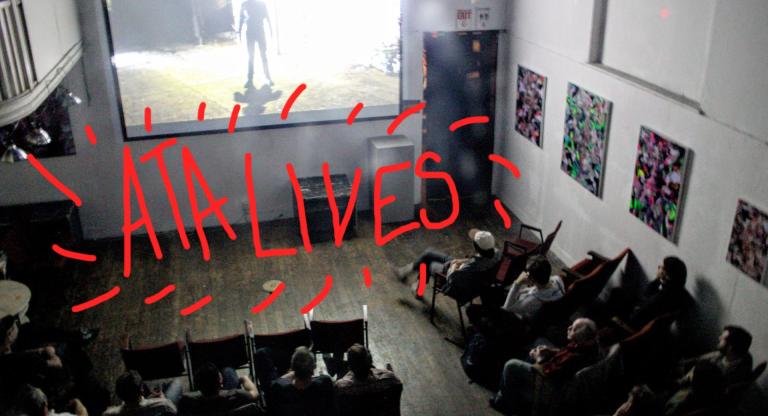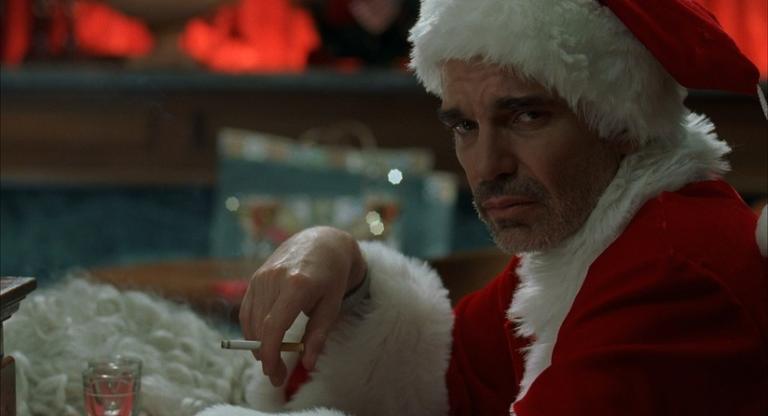Live music feeds off of the energy of the moment—the sense that you’re watching a performer reconstruct a song while driven by the mood of a room, and the potential for anything to happen next. This imbues concert films with a time-capsule allure, especially when it comes to genre-defining musical moments like the dawn of punk at CBGB.
Emily Armstrong and Pat Ivers didn’t have to rely on the passage of time to know what the CBGB set would represent. Borrowing video equipment from Manhattan Cable TV, where they worked at the time, they set out to document the downtown New York music scene—their filmography spans genres and venues, from peak-era Suicide to Pylon, from Richard Hell and the Voidoids to the Lounge Lizards, and even all the way to a New York appearance of Sun Ra and his Arkestra. They edited their footage into a TV show called Nightclubbing , and traveled the country to screen it for live audiences at galleries and screening spaces. They also helmed a live Video Lounge on the top floor of the original Danceteria, where clubbers could sit down inside an installation that zig-zagged between video art and a live feed of the bands playing downstairs. Through Ivers’s steady close-ups and soundboard-quality audio, the videos focus on how each song unspools in a live setting, and in their devotion to the music, they recreate the spell that a mesmerizing performance can cast.
This weekend, Anthology Film Archives hosts a quartet of Nightclubbing programs in what could be considered a sort of homecoming: Anthology also screened Nightclubbing in the ’70s and ’80s, using bleachers for seating. There may not be unconventional seating this weekend, but Armstrong and Ivers will give Q&As at each program, alongside one-off appearances from Suicide’s Martin Rev, the Patti Smith Group’s Jay Dee Daugherty, and the Dead Boys’ Jeff Magnum. To talk about the series, Screen Slate met with Armstrong and Ivers at a coffee shop close to Anthology on 2nd Avenue. On my way over, I walked by the John Varvatos boutique that occupies the former site of CBGB. With its slick front awning, it usually inspires a melancholy cognitive dissonance, but on that day, the storefront didn’t seem to hold quite so much obliterative power.
Let’s start at the beginning. How did you two meet?
Pat Ivers: We used to work together at Manhattan Cable TV’s Public Access Department, which was really wild and unruly back then. It was the very beginning of video, especially portable video. So I used to run classes and teach the community how to use video equipment, and I would get sent out to cover community events.
Emily Armstrong: I worked in programming. It was my first real job; I was about 21. Anybody could do a cable TV show, so they would come and pitch their ideas. We’d give them a time slot and I’d hook them up with Pat to produce it, or maybe a local production company, or sometimes they’d do it themselves. There was equipment at the cable company that they could rent. It was the very beginning of portable video—allegedly portable. The decks weighed like 40 pounds, and at least the black-and-white cameras were small enough to carry. They weren’t so gigantic that you could only do a show in the studio.
People were totally nuts; it was very exciting. The producers were all over the place: pornographers, astrologers, Boy Scout troops, churches, dominatrices. People would do a show for someone’s birthday party, and it would go on at 8:30 on a particular night so that they’d turn on the TV and it would be a surprise. But mostly people had serious TV shows. The people who worked there were really great and young. It was really cutting-edge, and it was the beginning of the whole television revolution. We were living it and people were writing about it, like Marshall McLuhan and Gene Youngblood.
How did you start filming shows together?
PI: I had been shooting bands with a bunch of guys for about a year in 1975. We had this ad hoc group called Metropolis Video, and we shot bands like Talking Heads and Blondie at CBGB’s. After about a year, they said, “We’re not making a lot of money with this.” And I’m like, “This is historic.” But they said, “We’re not doing it anymore.” They weren’t committed to the scene. Once the collective ended, with the exception of maybe one or two of them, they never went back to hang out at CBGB’s. Whereas, Emily and I lived there. So after six months where nothing was happening, I said to Emily, who I had just met, “Would you be interested in maybe going down to CB’s with me?” And she actually went with me, and totally got it.
EA: I loved it. I was a big fan of live music my whole life. I saw the Beatles when they came to America for the first time, and the Rolling Stones when they did afternoon shows at the Academy of Music. I grew up on Long Island and it was very easy for me to come into the city, so I used to go to shows at Cafe au Go Go and the Fillmore. Music had gotten so bad in the late ’70s, with bands like Yes and Asia...I can’t even describe how bad the bands were. But Pat took me to CB’s, and I was like, “Yes.” Real music, real musicians.
Do you remember the first show you went to together?
PI: Patti. The first time I saw Patti was at Max’s Kansas City with Television in ’74, and this was when Richard Hell was still in Television, so it was pretty amazing. I knew that everything was going to change when I saw her. But when Emily and I went, it was around ’76. The whole band was a real rock band by then—Richard Sohl and Jay Dee Daugherty had joined by that point.
EA: We interviewed Lenny Kaye extensively around 2002 for a collection of video interviews that we’re going to show at Anthology. He talks about Patti originally being like, “I’ll read my poems while you play guitar.” It built from there, and then they added Richard Sohl. She always wanted to be a rock star but it took a while.
PI: He also tells a story about the first time they went to CBGB’s. Earlier in the evening they went to the premiere of this concert film, Ladies and Gentlemen: The Rolling Stones. After the film, they got in a cab and went downtown to go to CB’s where they saw Television for the first time. It always seems so mythic. It’s just so perfect that that’s how the night shaped up.
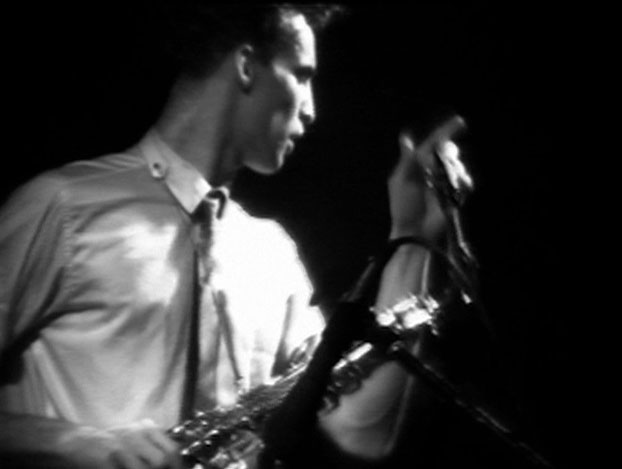
John Lurie in The Lounge Lizards, 1978
How did you develop your method for shooting shows?
EA: Pat shot everything, and shot it close. We didn’t have a big range of field with these crappy cameras, or any kind of zoom. So if you were the band, then Pat would have to be standing as close as she is to you right now [across a tiny coffee shop table].
PI: I always say that I would look through the lens and fall in love with the band. Also, I would just listen. What’s happening with the music? Is this person playing the important part now, or is it this person? So really, you just listen. It’s like acting.
EA: Other people started taping bands after us, but when I watch some of their videos, it’s like the camera will be on Johnny Thunders when someone starts playing a guitar solo offscreen. Why aren’t they shooting the guitar solo? Since we were major fans of the music, we knew who was going to sing next. We shot what you would be looking at, if you were in the room—unless you had a big crush on one of the musicians, and you’d be watching him the whole time…
PI: Occasionally you can see that...
It definitely simulates how your eye travels when you’re watching a show. Was it challenging to tape so steadily from the front row of a club?
PI: It’s funny, you had to be very zen, since there was no tripod. Everything was handheld, on my shoulder. And when you’re physically very centered, it’s also like you’re mentally very centered.
EA: In a lot of spaces, we’d have our deck, and I would stand there and say to people, “Don’t bump into her!”
PI: As time went on, we also would hire somebody to stand next to me. It would usually be someone we knew. We begged them. I mean, we burned our way through so many friends and acquaintances. When we worked at Danceteria, they actually gave us money to pay somebody to do that, because you can’t have people banging into you when you’re trying to shoot video.
How did the musicians react to being filmed?
EA: People were so happy to be videotaped and be on our show. We tried as much as possible to give them copies of the tapes, since back then there was no way to easily get them, so they were very precious. When we worked at CB’s, we started shooting in color—we got the revolutionary color camera, the Sony DXC-1610, which we’re actually donating to a museum in Atlanta because it’s so antiquated! But you had to put so much light on these people, so we had purchased a lighting kit with four lights that we’d clamp on bars. That’s why, in a lot of these videos, the sweat is pouring off the musicians, because the lights were baking them.
PI: One of the first bands we taped in color was Richard Hell. We had these incredibly hot lights, and it happened also to be the night that David Bowie was in the audience. After the third song, he leaned over to me and said, “Pat, turn the lights off.” I was like, “Okay, Richard!” So we switched over to black-and-white since we had our backup camera. We were always prepared, with bags of adapters and backup equipment—the Girl Scouts of video. Go early, stay late.
What was the first show you shot?
EA: The Dead Boys. I fell in love with the Dead Boys. They’re one of our closest bands, in terms of still being friends with the band. We taped them three times, and we’re showing a pretty amazing full concert of theirs at Anthology. Jeff Magnum, who was their bass player, is going to do the Q&A with us afterwards, which livens it up a little bit. We did this in Los Angeles when we showed at the Cinefamily—Cheetah Chrome was there just by coincidence, so he came up to do a Q&A. It was hilarious, like punk rock standup. People asked him questions about music and stuff that we could never really answer, just because we’re not musicians. So we’re going to try that at Anthology: Martin Rev is coming for the Suicide screening, and Jay Dee Daugherty is coming for the night we do the interviews and the greatest hits. He’s extensively in the interviews.
Do you enjoy doing Q&As? What is it like to show these videos to modern audiences?
PI: We love them. People sometimes have so many questions.
EA: We know a lot of personal stuff. People will ask things like, “Was that the DNA concert where this bootleg DVD was shot?” And we’ll say, “We don’t know the answer to that.” I can tell you who a musician slept with, but I don’t know anything about his bootleg DVDs! But we get a lot of fans who know minutiae of information about the bands, their music, their concerts.
PI: And they ask questions about archiving, and equipment. The inevitable “What was it like to be girls in a man’s world?” question always comes up. They always say, “How did you know that this was an important thing to record?” And then someone always says, “Did you tape the…” and they’ll name some really obscure band. Or they’ll ask if we taped some really big band, like the Ramones, which we didn’t. That’s because Lisa Robinson, who writes for Vanity Fair, her husband Richard had some video equipment. Since he was close to the band, he was like, “I’m the only one allowed to tape the Ramones.”
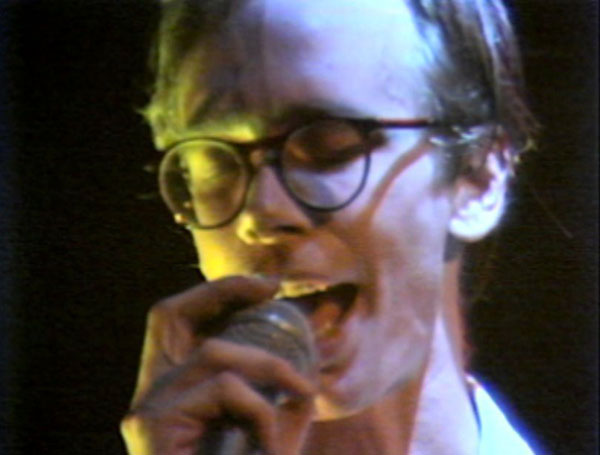
Arto Lindsay in DNA, 1979
EA: I don’t think he even has any of those videos. They’ve never materialized.
PI: I think he might have done it once or twice, at the beginning. Maybe they were terrible and he never did anything with them, but it’s so sad. Patti’s manager Jane Friedman, who runs the Howl Gallery on 1st Street, said her biggest regret is that she didn’t let us videotape Patti. It’s interesting; this was one of the big differences between the American scene and the British scene. In the American scene, people were very private, but in the British scene, they were like the first reality TV stars. They were all about publicity: look at me, I’m going to shock you. The American bands were introverts, basically.
EA: Losers in high school who got a second chance to be stars in CBGB’s high school. That’s why everybody liked each other so much, because everybody hated us in high school. And then there were the CBGB’s cliques: the junkie clique, the No Wave clique, the Ramones clique. Our crowd was the tech crew, the group of people that worked at CBGB’s, since we had to get there before the club opened, and we had to leave when the club closed, dragging these enormous anvil cases in and out. We were friends with the musicians, but really, there were cliques. But we all came together, just like in high school, for those pep rallies.
All in the name of the music! How do these cliques come across to you now, looking back at your archive?
EA: There was a real DIY situation. Everybody felt like they had to do something. There were a lot of fanzines that were Xeroxed and stapled together that would come out on Tuesday night—it was called Tuesday Night, actually. Anya Phillips did that one. Then there was the beginning of Punk magazine [created by Legs McNeil, John Holmstrom, and Ged Dunn in 1975]. There were artists, like Duncan Hannah. And there were writers. Richard Hell was kind of a writer, kind of a musician.
PI: Lester Bangs.
EA: Lester Bangs, of course. So this was what we did, the videos. We were the only people doing it, and we were girls. We wore high heels and crazy clothes. But Pat and I also never got grants, even though I wrote so many grants for New York State Council of the Arts when I had a video training program. I always thought, “What are we missing?” I think there was a bias against us because we were working in video, not film, and we were women, and we were shooting punk rock, and we had a certain amount of attitude and stuff.
PI: Like I said, when I saw Patti in 1974, I knew. I can’t tell you how many arguments I’ve had with family members, with boyfriends, with people I worked with, who kept saying over and over, “You’re crazy. What are you doing? Why are you wasting your time like this? It’s pointless.”
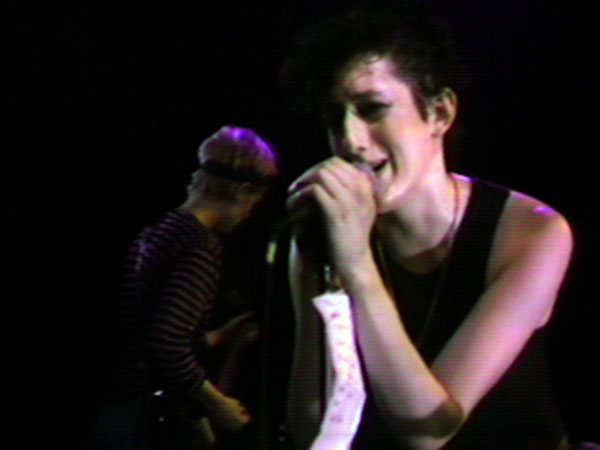
Cynthia Sley in Bush Tetras, 1980
But it’s coming out of that DIY ethos, and you have to follow the feeling. When I was in high school, I followed a lot of my favorite bands by seeking out the highest quality YouTube bootlegs, so this type of well-shot concert footage with soundboard-quality audio is so precious for fans.
EA: We were really fussy about our audio. We started out with half-inch reel to reel video. It was an open reel, and the tape was on it, and at the beginning, sometimes people even cut it to edit it, but we transferred it electronically. Then we went up to three-quarter inch video, which had two channels of audio. We had a mic in the room, and then we had a line in, so it was good backup.
CBGB’s also had the most amazing sound system. Nowhere could really hold a candle to the sound system at CB’s, except maybe The Rat in Boston. Pat and I went to every club, even traveling around the country. We didn’t call it Nightclubbing for nothing! But CBGB’s even did a separate mix just for our videos. When they finally got a little four-channel mixer, they put it on our line in.
PI: The room itself was amazing. There are some spaces that just have amazing audio, and that was one of them. Even if you listen to just the hand mic that we had leaning on top of the stage, it sounds great.
EA: Sometimes we’d go to clubs and they would fuck us. We’d think we had the sound, but then all of a sudden we didn’t, so we had to rely on their mic in the room.
PI: That was like when we did Iggy at Hurrahs.
EA: Anytime we went to Hurrahs, they would say, “It’s all taken care of this time!” Because it’s not like you can listen on the headset since you’re in a room where it’s like nine decibels. You can’t even hear anything. So it’s like, “Check this out!” “Oh, right.”
PI: They would just say to us flat out, “We’re not letting you take a peek at the board.” Our experience really depended on the manager of the club. Most people were pretty affable. Hurrahs were never affable, but what are you going to do?
When did you move into installations as a format for Nightclubbing ?
PI: I always worked in video art. One of the ways I kept myself afloat while doing all of this was that I worked at Electronic Arts Intermix. I worked there for years, with Nam June Paik...
I’d been meaning to ask you about working with him!
PI: Yeah! I worked with Nam June a lot. That was really my milieu. If we weren’t going to a club, we’d be going to an art show. That was what everybody did; it was a very porous scene.
EA: It also meant free white wine and crappy cheese—dinner! We were pretty connected to the video art community, but we were also dissed a lot. It didn’t bother me, though. We got to hang around Joey Ramone and Richard Hell, and listen to the greatest music. When we did our show at Anthology years and years ago, the video curators were Shigeko Kubota, who was Nam June’s wife, and Ann Volks, my old friend from when I was 16. They basically approached us, since nobody was showing video there at the time. People were like, “Video is not art,” since people cared about stuff like that back then. I’m sure a lot of it had to do with Pat’s connection with Nam June. They knew we were legit.
The other thing is, when we started showing our videos, there was nowhere to show them, and we had to bring in all of our own equipment. We had to have a bunch of TV sets, and we had this crazy black-and-white video projector that looked like a giant bullet. I think we stole it from Manhattan Cable or something. So when we did a show at the Mudd Club, we had to bring in our own TV sets, and then we wrestled up some columns, and wrapped tiger and cheetah print fabrics around the columns. We would project the videos on a big piece of white seamless paper, and for the screen, we would draw an old ’50s TV, with the antenna. For an installation at the Kitchen, our friend Robin’s brother sent us a gigantic floral arrangement that was an old TV that they took the screen out of, so that the flowers looked like they were exploding out of the TV set. So we had to do installations, since otherwise we couldn’t show our videos.
How did the Video Lounge at Danceteria come together?
PI: There was this thing called the Pop Front, and it was a nonprofit…
EA: Reacting to clubs charging 25 dollars for entry.
PI: Probably like 10 dollars! It was a group of about 15 people who put on rock shows at the Machinists Union Hall on 15th Street. Emily and I were the beverage committee. The organizer was Jim Fouratt, and this was really his way of deciding who he was going to hire when he became the manager of Danceteria. After three weeks of us running these shows at the Machinists Hall, he did exactly what he didn’t want people to do, which was that he had a velvet rope, charged people a lot of money, and basically picked out all the people that he liked from this group. So he hired us to do a video installation for the opening night, and we did this Video Lounge thing on the top floor—I think Danceteria was the first multi-floor club for our scene. This would have been around 1980. It was super successful, so it became a permanent feature of the club.
So you video DJed there. What was the format?
EA: We had a huge archive of our own material by that point, and we were also collectors of video. We had everything: old trailers, commercials from the ’50s, cartoons, pornos, early music videos. Video had gotten cheap enough by then that visual artists had started working in video, so people like Keith Haring and Kenny Scharf would come in and go, “Hey, I made a video!” We would play them, as long as they weren’t boring and endless; it had to move along. Then we videotaped the bands live. The basement was the DJs, the main floor was the live music, and the Video Lounge was the third floor. So you could go downstairs into the sweaty, crowded performance floor and watch the bands, or you could stay upstairs and watch them on TV in the Video Lounge. A lot of people did that, and we shot them downstairs. We had a better camera then.
But the club was also very illegal and unlicensed, and the mafia was involved. Then there became a question about who owned the videotapes—we were like, “We own the videotapes.” Then we took most of our tapes out, but we got busted for working in an illegal, unlicensed, after-hours club. We got put in a paddy wagon and got driven downtown and spent the night in jail. But I was a photographer then, and they let me keep my camera, so I have all of these great pictures of us and Zoe Leonard and other people in jail. We made a video about it called Chain of Fools, like the Aretha Franklin song. It’s very funny.
PI: Our apartment was also robbed about four months before the club closed, so we had video equipment stolen. While the club was open, it was robbed twice. They took all of our video monitors. I mean, we’d never worked with mafia club owners before. It had always been sole proprietors. At the end of the night, you’d go in to get paid, and there would be a gun on the table and the manager and the assistant manager counting out the money…
EA: Piles and piles and piles and piles of money!
PI: And this big security guy is sitting there with another gun. I mean, we’d never experienced that before. So when it got robbed, we lost a lot of our videotapes, and it was really terrible. A lot of great stuff—Nico, R.E.M., Devo.
EA: It was the first time R.E.M. had played in New York, too. Tons of stuff. I’d say we lost 20 percent of our collection.
PI: After this, I started taking videos home with me from the club to make copies, and then I’d bring them back to put them on the shelves for our video DJ sets. So thank god.
EA: Although we don’t have copies of everything. Keith Haring made this unbelievable video of him in the shower having sex with all of these guys to some song. If we owned that today, we’d be millionaires!
What was your favorite rediscovery while going through and archiving the collection?
PI: John Cale at Irving Plaza. I have no memory of videotaping it. Obviously it happened. The one thing that I vaguely remember is that his manager said we weren’t allowed to use it. I think the Cramps were the headliners, and we went there to tape them. It’s funny because I knew one of the guys in John Cale’s band. The very first band I ever videotaped at CBGB’s when I was with Metropolis Video was the weekend of the Unrecorded Band Festival. The first night, we taped Talking Heads, Blondie, the Heartbreakers, and Joe & Blake, a folk rock duo. So one guy from Joe & Blake, Joe Bidewell, went on to play in all these different bands, and he was the keyboard player for John Cale. They were terrific, but they were a folk rock duo. At that time, it just seemed like another musical form. It didn’t feel weird, and no one was booing them. It was just like, okay, these guys seem like good musicians.
EA: It was called punk rock, but it was Hilly’s rules. You could play anything you wanted as long as you didn’t play covers. He wasn’t going to narrowly focus it into punk rock. He just wanted music. I never heard anybody get booed at CBGB’s. Ever!
